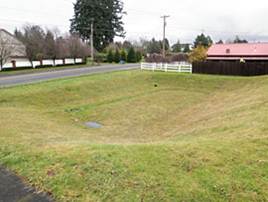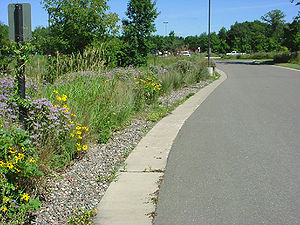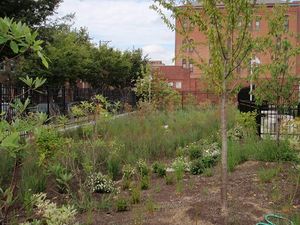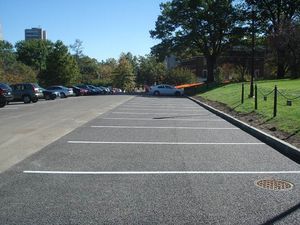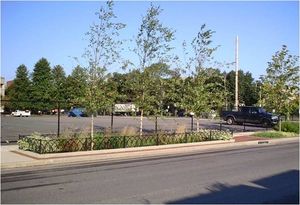
This site was recently updated and is undergoing review. Please submit comments to Mike Trojan at the MPCA. Anticipated completion date is August, 2015.
Best Management Practices that infiltrate stormwater runoff into underlying soil include, but are not limited, to
- infiltration basins,
- infiltration trenches,
- underground infiltration,
- bioinfiltration,
- permeable pavements, and
- tree trenches and tree boxes.
These are discussed briefly below.
Contents
Infiltration basin
| Applications and treatment capabilities for infiltration basins | |||
| Applications | Treatment capabilities3, 4, 5 | ||
| Residential | Yes | TSS | High6 |
| Commercial | Yes | TN | Medium/high |
| Ultra-urban | Limited1 | TP | Medium/high |
| Industrial | Yes2 | Chloride | Low |
| Highway/road | Limited | Metals | High |
| Recreational | Yes | Oils and grease | High |
| Pathogens | High | ||
| 1 Due to a size restriction; 2 Unless the infiltration practice is located in an industrial area with exposed significant materials or from vehicle fueling and maintenance areas. Infiltration BMPs are PROHIBITED in these areas; 3Underground infiltration systems may have different (likely lower) pollutant removal capabilities than what is provided in this table. These systems may have a wider application range. 4 This is only for the portion of flow that enters the infiltration basin; by-passed runoff does not receive treatment; 5 Low = < 30%; Medium = 30-65%; High = 65 -100%); 6 Assumes adequate pre-treatment Sources: Schueler, 1987, 1992; USEPA 1993a, 1993b; Maniquiz et al., 2010; NPRPD, 2007; California Stormwater Manual, 2009; Pennsylvania Stormwater Manual, 2006 | |||
An infiltration basin is a natural or constructed impoundment that captures, temporarily stores, and infiltrates a design volume of water. For more information, see the following pages in this Manual.
- Overview for Infiltration basin
- Design criteria for Infiltration basin
- Construction specifications for Infiltration basin
- Operation and maintenance of Infiltration basin
- Cost-benefit considerations for Infiltration basin
- Calculating credits for infiltration basin
- External resources for Infiltration basin
- References for Infiltration basin
- Requirements, recommendations and information for using infiltration basin/underground infiltration BMPs in the MIDS calculator
Infiltration trench
| Applications and treatment capabilities for infiltration trenches | |||
| Applications | Treatment capabilities3, 4 | ||
| Residential | Yes | TSS5 | High5 |
| Commercial | Yes | TN | Medium/high |
| Ultra-urban | Limited1 | TP | Medium/high |
| Industrial | Yes2 | Chloride | Low |
| Highway/road | Yes | Metals | High |
| Recreational | Yes | Oils and grease | High |
| Pathogens | High | ||
| 1 Due to a size restriction; 2 Unless the infiltration practice is located in an industrial area with exposed significant materials or from vehicle fuelling and maintenance areas. Infiltration BMPs are PROHIBITED in these areas; 3 This is only for the portion of flow that enters the infiltration basin; by-passed runoff does not receive treatment; 4 Low = < 30%; Medium = 30-65%; High = 65 -100%); 5 Assumes adequate pre-treatment Sources: Schueler, 1987, 1992; USEPA 1993a, 1993b; Maniquiz et al., 2010; NPRPD, 2007; California Stormwater Manual, 2009; Pennsylvania Stormwater Manual, 2006 | |||
An infiltration trench is a shallow excavated trench that is backfilled with a coarse stone aggregate. This design allows for the temporary storage of runoff in the void space of the material in addition to the storage above the aggregate within the trench. For more information, see the following pages in this Manual.
- Overview for Infiltration trench
- Design criteria for Infiltration trench
- Construction specifications for Infiltration trench
- Operation and maintenance of Infiltration trench
- Cost-benefit considerations for Infiltration trench
- Calculating credits for infiltration trench
- External resources for Infiltration trench
- References for Infiltration trench
- Requirements, recommendations and information for using infiltration basin/underground infiltration BMPs in the MIDS calculator
Bioinfiltration basin
| Applications and treatment capabilities for bioinfiltration basins | |||
| Applications | Treatment capabilities2, 3 | ||
| Residential | Yes | TSS | High4 |
| Commercial | Yes | TN | Low/Medium5 |
| Ultra-urban | Limited | TP | Medium/high6 |
| Industrial | Yes1 | Chloride | Low |
| Highway/road | Yes | Metals | High |
| Recreational | Yes | Oils and grease | High |
| Pathogens | High | ||
| 1 Unless the infiltration practice is located in an industrial area with exposed significant materials or from vehicle fuelling and maintenance areas. Infiltration BMPs are PROHIBITED in these areas; 2 This is only for the portion of flow that enters the infiltration basin; by-passed runoff does not receive treatment; 3 Low = < 30%; Medium = 30-65%; High = 65 -100%); 4 Assumes adequate pre-treatment; 5 This assumes no raised underdrain; 6 Certain soil mixes can leach P. Sources: EPA Factsheet, 1999; Davis et al., 2001, 2003, 2006; Hsieh and Davis, 2005; Hong et al., 2006; Hunt et al., 2006; NPRPD, 2007; Li and Davis, 2009; Diblasi et al., 2009; Passeport et al., 2009; Brown et at., 2011a, b; Komlos et al., 2012; Denich et al., 2013; Li and Davis, 2013; California Stormwater BMP | |||
Bioinfiltration basins, often called rain gardens, use soil (typically engineered media or mixed soil) and native vegetation to capture runoff and remove pollutants. Both the media and underlying soil typically have high infiltration rates that allow captured water to infiltrate within a required drawdown time, usually 48 hours. For more information, see the following pages in this Manual.
- Bioretention terminology (including types of bioretention)
- Overview for bioretention
- Design criteria for bioretention
- Construction specifications for bioretention
- Operation and maintenance of bioretention
- Cost-benefit considerations for bioretention
- Calculating credits for bioretention
- Soil amendments to enhance phosphorus sorption
- Summary of permit requirements for bioretention
- Supporting material for bioretention
- External resources for bioretention
- References for bioretention
- Requirements, recommendations and information for using bioretention with no underdrain BMPs in the MIDS calculator
Permeable pavement
| Applications and treatment capabilities for permeable pavement | |||
| Applications | Treatment capabilities2, 3 | ||
| Residential | Yes | TSS | High4 |
| Commercial | Yes | TN | Medium/High |
| Ultra-urban | Yes | Nitrate | Low/Medium |
| Industrial | Yes1 | TP | Medium/High |
| Retrofit | Yes | Chloride | Low |
| Highway/road | Yes | Metals | High |
| Recreational | Yes | Oils and grease | High |
| Pathogens | 5 | ||
| 1 Unless the infiltration practice is located in an industrial area with exposed significant materials or from vehicle fuelling and maintenance areas. Infiltration BMPs are PROHIBITED in these areas; 2 This is only for the portion of flow that enters the infiltration basin; by-passed runoff does not receive treatment; 3 Low = < 30%; Medium = 30-65%; High = 65 -100%); 4 Assumes adequate pre-treatment; 5 Insufficient information Source: Schueler, 1987; Pratt et al, 1999; Adams, 2003; Brattebo and Booth, 2003; Adams, 2003; Bean et al, 2007; SEMCOG, 2008; International Stormwater Database, 2012 | |||
Permeable pavements allow stormwater runoff to pass through surface voids into an underlying stone reservoir/ subbase for temporary storage and/or infiltration. They are suitable for driveways, trails, parking lots, and roadways with lighter traffic. For more information, see the following pages in this Manual.
- Overview for permeable pavement
- Types of permeable pavement
- Design criteria for permeable pavement
- Construction specifications for permeable pavement
- Assessing the performance of permeable pavement
- Operation and maintenance of permeable pavement
- Calculating credits for permeable pavement
- Additional considerations for permeable pavement
- Links for permeable pavement
- References for permeable pavement
- Requirements, recommendations and information for using permeable pavement BMPs in the MIDS calculator
Tree box/Tree trench
| Applications and treatment capabilities for tree box/tree trench | |||
| Applications | Treatment capabilities2, 3 | ||
| Residential | Yes | TSS | High4 |
| Commercial | Yes | TN | Low/Medium |
| Ultra-urban | Yes | TP | Medium/High5 |
| Industrial | Yes1 | Chloride | Low |
| Highway/road | No | Metals | High |
| Recreational | Yes | Oils and grease | High |
| Pathogens | High | ||
| 1 Unless the infiltration practice is located in an industrial area with exposed significant materials or from vehicle fuelling and maintenance areas. Infiltration BMPs are PROHIBITED in these areas; 2 This is only for the portion of flow that enters the infiltration basin; by-passed runoff does not receive treatment; 3 Low = < 30%; Medium = 30-65%; High = 65 -100%); 4 Assumes adequate pre-treatment; 5 Certain soil mixes can leach P. Source: see [1] | |||
Tree trenches and tree boxes (collectively called tree BMPs), consist of trees planted within underground storage reservoirs designed to retain a volume of runoff for the purpose of uptake by trees. They are a variant of bioretention BMPs. For more information, see the following pages in this Manual.
- Trees - general
- Overview for trees
- Types of tree BMPs
- Plant lists for trees
- Street sweeping for trees
- References for trees
- Supporting material for trees
- Tree boxes/tree trenches
- Design guidelines for tree quality and planting - tree trenches and tree boxes
- Design guidelines for soil characteristics - tree trenches and tree boxes
- Construction guidelines for tree trenches and tree boxes
- Protection of existing trees on construction sites
- Operation and maintenance of tree trenches and tree boxes
- Assessing the performance of tree trenches and tree boxes
- Calculating credits for tree trenches and tree boxes
- Case studies for tree trenches and tree boxes
- Soil amendments to enhance phosphorus sorption
- Fact sheet for tree trenches and tree boxes
- Requirements, recommendations and information for using trees as a BMP in the MIDS calculator
Underground infiltration and dry wells
Underground infiltration systems and dry wells have been installed below parking lots and other impervious surfaces on sites where insufficient space exists for a surface infiltration system. They are designed to temporarily store stormwater runoff before slowly infiltrating the water into the subsurface (Connecticut, 2004). There is limited information on the effectiveness of these systems in removing pollutants. Limited data suggests they may be less effective at removing mobile pollutants than surface-based infiltration systems.
One concern is that underground infiltration may meet the U.S. Environmental Protection Agency (EPA) definition of a Class V injection well. Class V injection wells are defined as any bored, drilled, or driven shaft, or any dug hole that is deeper than its widest surface dimension. Class V injection wells can also be an improved sinkhole, or a subsurface fluid distribution system (from U.S. EPA, June 2003). The U.S. EPA administers Class V injection well permits in Minnesota. Minimum requirements for installing, permitting, and operating a Class V well is defined by the USEPA.
A second concern pertains to the overall pollutant removal effectiveness of those underground infiltration systems that do not meet the definition of a Class V injection well. The document released by the Transport Research Synthesis titled “Issues of Concern Related to Underground Infiltration Systems for Stormwater Management and Treatment” provides a good overview of the concerns related to underground infiltration systems (MNDOT, 2009). Issues identified in this report include:
- There is potential that an underground infiltration system meets the criteria of a Class V injection well.
- There is insufficient knowledge of the fate of pollutants in the subgrade below the buried infiltration systems.
- Roadways and parking lots with high volumes of traffic have higher concentrations of certain pollutants, including heavy metals and PAHs. Pretreatment devices, such as sumps, may be necessary to protect the subgrade and groundwater.
- Underground systems do not allow for the pollutant removal that is accomplished through biological activity and vegetation uptake.
- The minimum separation requirement of 3 feet between the bottom of the infiltration system and the seasonally high groundwater elevation may be insufficient for adequate pollutant removal. Additional study is recommended.
- Maintenance of underground systems is critical for effective pollutant removal. However, access for maintenance is challenging. There are concerns that the difficult access is preventing owners from properly maintaining these systems.
This Manual currently does not provide guidance for design, construction, maintenance, and assessment of underground infiltration systems.
Unit processes for different infiltration BMPs
The following table provides a summary of unit processes for the different infiltration BMPs.
Unit processes of stormwater treatment techniques (Adapted from WEF, 2008)
Link to this table
| Control | Infiltration basin | Infiltration trench | Bioinfiltration | Permeable pavement | Tree box/tree trench | Enhanced turf |
|---|---|---|---|---|---|---|
| Peak flow attenuation | X | X | X | X | ||
| Runoff volume reduction | X | X | X | X | X | |
| Infiltration | X | X | X | X | X | X |
| Dispersion | ||||||
| Evapotranspiration | X | X | ||||
| Runoff collection and usage | X1 | X1 | ||||
| Sedimentation | X | X | X | |||
| Flotation | X | X | ||||
| Laminar separation | ||||||
| Swirl concentration | ||||||
| Sorption | X | X | X | X | ||
| Precipitation | X | X | X | X | ||
| Coagulation | X | X | X | X | ||
| Filtration | X | |||||
| Plant metabolism | X | X | X | |||
| Nitrification/denitrification | X | X | X | |||
| Organic compound degradation | X | X | X | X | ||
| Pathogen die off | X | X | X | |||
| Temperature reduction | X | X | X | X | ||
| Disinfection | X | X | X | X |
1 If underdrain is present
Related pages
- Overview of stormwater infiltration
- Pre-treatment considerations for stormwater infiltration
- BMPs for stormwater infiltration
- Pollutant fate and transport in stormwater infiltration systems
- Surface water and groundwater quality impacts from stormwater infiltration
- Stormwater infiltration and groundwater mounding
- Stormwater infiltration and setback (separation) distances
- Karst
- Shallow soils and shallow depth to bedrock
- Shallow groundwater
- Soils with low infiltration capacity
- Potential stormwater hotspots
- Stormwater and wellhead protection
- Stormwater infiltrations and contaminated soils and groundwater
- Decision tools for stormwater infiltration
- Stormwater infiltration research needs
- References for stormwater infiltration
